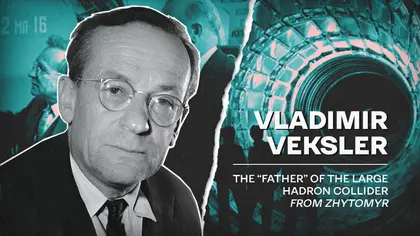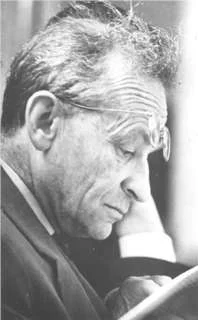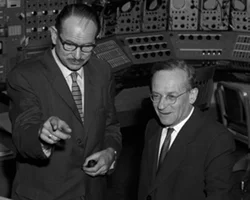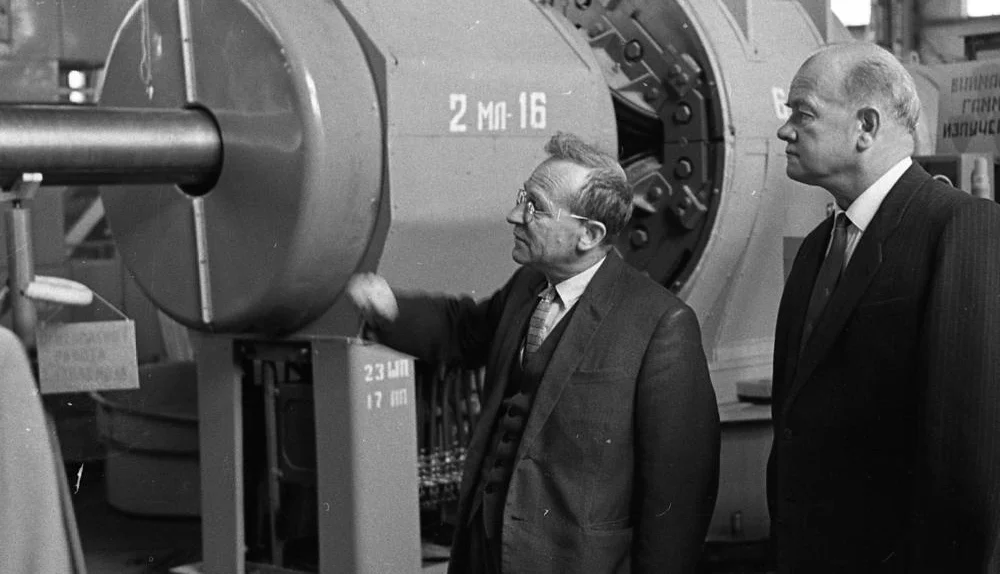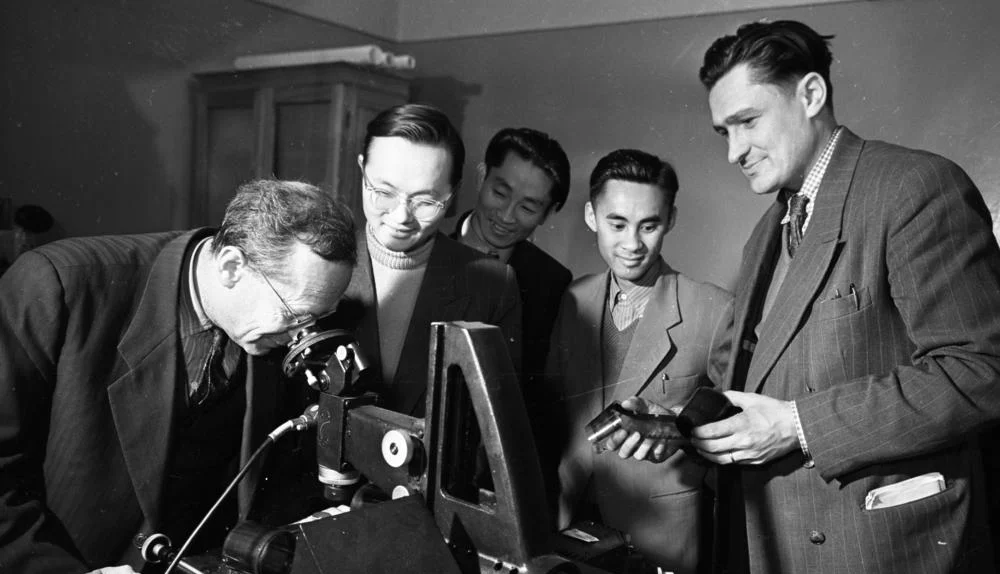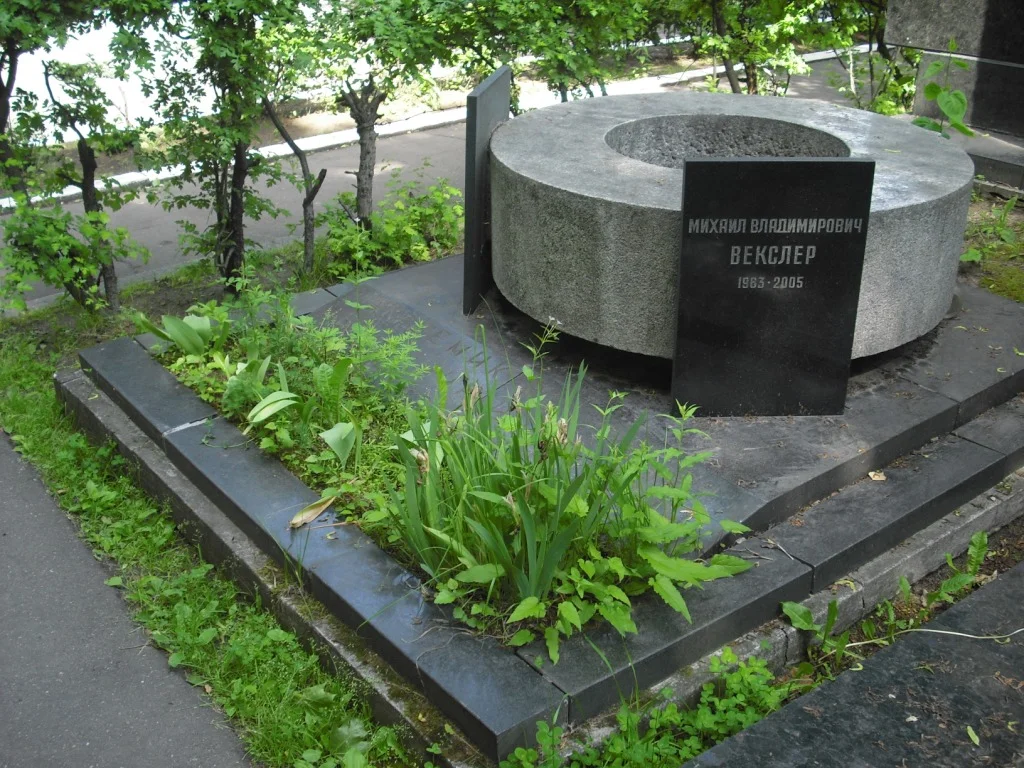VLADIMIR IOSIFOVICH VEKSLER was a specialist in problem of the acceleration of charged particles, and a scientist who studied high energy physics and cosmic rays. He was the inventor of the synchrotron, which became the prototype of the Large Hadron Collider and the discoverer of the “autophasing principle”. He developed the defi nitions for “phase oscillation”, “synchrotron”, “phasotron”. There is even a scientifi c term “Veksler’s autophasing” named after him.
Vladimir Veksler at his desk
HOW THE “UNBREAKABLE” BARRIER WAS BROKEN
Vladimir Veksler graduated from university at the age of 24 and started working with the nuclear physics. Working at the Lebedev Physical Institute (Moscow), Veksler dealt with the problem of the acceleration of heavy charged particles which involved these experimental devices:
• a phasotron (a device in which the magnetic field is homogeneous and constant over time while its frequency changes),
• a microtron (a particle accelerator with a different layers of acceleration),
• a synchrotron (a synchronous cyclic particle accelerator). The scientist was directly involved in the discovery of an elementary particle that was unknown before: the anti-sigma minus bayron particle, which can exist only for one 10-billionth of a second. 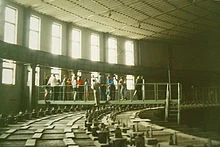
Everything you need to know about the Large Hadron Collider.
The discovery of the phenomena of autophasing in 1944 can be considered the scientist’s big break. Due to an increase in the energy of particle accelerators, they were over to overcome a relativistic barrier that has long been considered “unbreakable”. However, there was still the problem of the mismatch between the particle’s rotation frequency in the cyclotron and the acceleration field. Vladimir Veksler figured out how overcome this limitation. 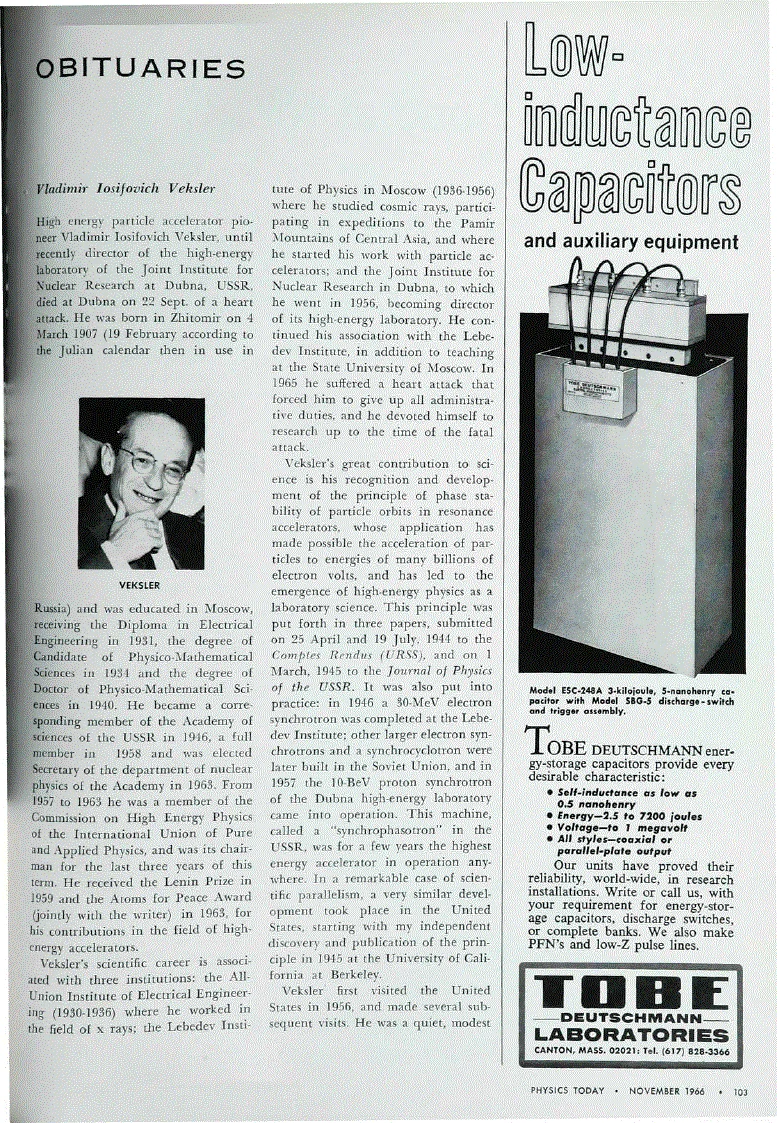
Artiсle about Veksler works,1966.
Under his leadership, the world’s first synchrophasotron was built in 1957, using the principle of autophasing. For three years it remained the most powerful in the world and, in fact, became the prototype of the Large Hadron Collider.
Since then, Veksler’s name has forever been associated with the development of innovative particle acceleration techniques. All the most powerful particle accelerators are built based on the Weksler autophase principle.
A GREETING TELEGRAM FROM THE PRESIDENT OF THE USA
The Veksler autophase principle was discovered in 1944. He was extremely surprised when a few months later, the Physical Review journal published an article that the invention was patented by the American Edwin McMillan. Was this some kind of unprecedented plagiarism.
The Zhytomyr-born scientist sent a letter to the editorial office and received an answer from culprit himself. McMillan wrote: “My lack of attention to your work was unintentional, and having learned of it, I would like to confirm that your discovery preceded mine.”
Edwin McMillan and Vladimir Veksler
When they were both awarded the Atom for Peace Prize in 1963, the US President Lyndon Johnson sent a greeting telegram to Veksler: “I am again convinced of the international nature and language of true science. Its goals and methods... know no political boundaries. This is evident in the discovery made by you and Dr. McMillan practically at the same time.”
When receiving the aforementioned award in the US, Veksler replied: “It is remarkable that I share this high prize with my American colleague Edwin McMillan. … There is the only one nature. Very often at this stage, the tasks that the development of science sets befor us have a single solution. And it certainly doesn’t depend on where, in the Soviet Union or in the United States of America, there are people are trying to find that solution.”
HE DID NOT RECEIVE A NOBEL BECAUSE OF “SECRECY”
Veksler was nominated five times for the Nobel Prize in Physics. He was not only nominated on the initiative of the Soviet Academy of Sciences, but also by scientists from Sweden, the United States and the United Kingdom. Unfortunately, the Zhytomyr-born scientist remained a multiple-nominee without ever getting a Nobel, which he certainly deserved because of his inventions. This was primarily because the USSR, for reasons of secrecy for their atomic program, refused to provide the relevant documents.
JOIN US ON TELEGRAM
Follow our coverage of the war on the @Kyivpost_official.
Vladimir Veksler near the synchrophasotron coil
Some of the Veksler’s colleagues claim that the Ukrainian-born scientists has been nominated for the Award not five, but 9 times. However, there are no proofs yet in open sources: these nominations may have been classified.
Some streets of Zhytomyr, Odesa, Dubna and even CERN (the site of the European Organization for Nuclear Research, which created the Large Hadron Collider, near Geneva, Switzerland) are named after Vladimir Veksler.
Vladimir Veksler with a students.
INTERESTING FACTS
- As a child, the future brilliant physicist spent several years in a privileged boarding school, which was personally overseen by the People’s Commissar of Enlightenment Anatoly Lunacharsky.
- Physicist Henri Rukhadze mentioned Volodka (Vladimir) Veksler in his memoirs. Veksler is one of the heroes of Anton Makarenko’s “Pedagogical Poem”.
- In the event of the failure of the opening of the first synchrophasotron, Veksler could have gotten arrested “ for sabotage”.
- For reasons of special secrecy, the scientist’s laboratory in the USSR was officially named just: “Benchmark”.
- At the beginning of 1935, Veksler was awarded cloth to make a suit with because of his excellent work as an “X-ray team researcher”.
- In order to financially support the staff, he regularly assisted his subordinates, secretly paying part of their allowances, which they then redeemed as trade union benefits, or made invoices and handed “budget payments” to students.
- Veksler was an art connoisseur. His daughter mentioned that he had a solid library at home. His favorite author was Alexander Pushkin.
- He was also interested in painting: he admired the works of the Impressionists. He liked to listen to music by Bulat Okudzhava and Alexander Galich.
- The tombstone of this Zhytomyr-born genius is made in the form of a synchrophasotron.
The scientist’s tombstone is made in the form of a synchrotron.
FROM THE DOSSIER OF VLADIMIR VEKSLER
• Veksler was born on March 4, 1907, in Zhytomyr.
• He graduated from the Moscow Power Engineering Institute (1931).
• He was the winner of the USSR Academy of Sciences Award (1937).
• He was the winner of the USSR State Prize (1951).
• He was a Laureate of the International Award Atom for Peace (1963). • He was an honorary Doctor of the Prague Higher Technical School (1963).
• He died on September 22, 1966 in Moscow after a third heart attack.
• At the Joint Institute for Nuclear Research (Dubna, Russia) there is a Laboratory of High Energies Physics named after Veksler.
This article by Nadiia Avramchuk and Mykola Sukhomozsky is reprinted with the publisher's permission from the book (UN)Celebrated Ukrainians Who Changed the Course of History, SAMIT-KNYHA, Kyiv, 2020.
You can also highlight the text and press Ctrl + Enter


